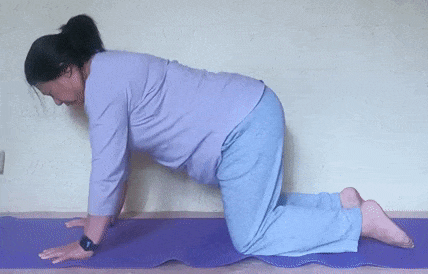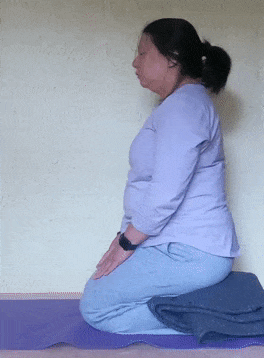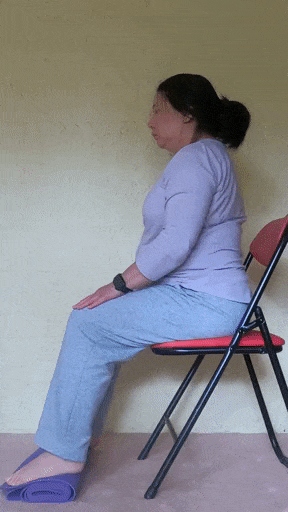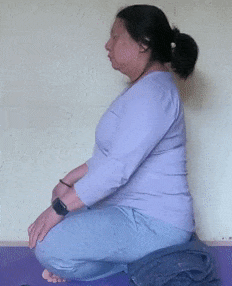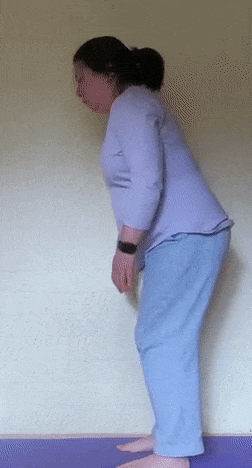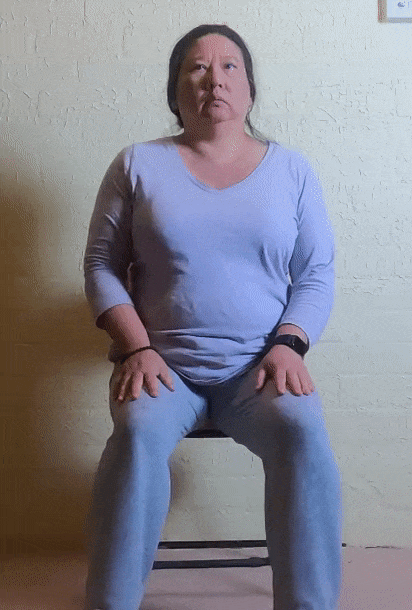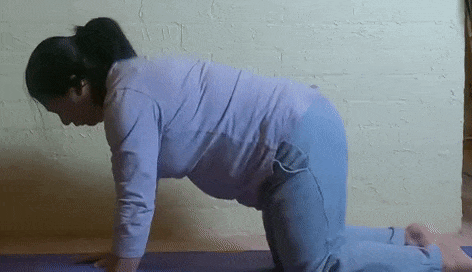Practice Point: Cat
Marjariasana or cat, is a simple movement that is accessible to many people. Some refer to the movement as cat-cow comprising two separate postures: cat being the rounded-back posture, and cow the arched back-open chest posture.
Cat is a favourite of mine and a posture you’ll see in many of my classes. It’s a great movement for warming up the spine and I use it in my classes as a basis for other variations and postures.
Before you begin ...
Be cautious if you:
- Have osteoporosis
- Have back or neck problems
- Have abdominal problems or recent abdominal surgery
- Are pregnant
Choose a starting position that feels good for you and be cautious how much you flex your spine or how much pressure you place on your abdomen.
The practice
Cat can be performed from your hands and knees, kneeling, sitting on the floor or in a chair, or standing.
Hands and knees
Cat from hands and knees
Come onto your hands and knees.
Position the knees beneath the hips and have the knees either hip-width apart or the knees, legs and feet together.
Try rolling up your mat or placing a blanket under your knees for padding.
Choose one of the following arm positions:
Place your palms flat on the floor with your fingers spread wide.
Consider rolling up a mat or towel and placing the palms on the mat and the fingers over the edge.
Make fists and rest your knuckles on the floor with the palms facing each other.
Place your forearms on the floor, a bolster, blankets, or blocks.
Start by positioning the wrists or the elbows (if you’re resting on your forearms) below your shoulders.
Does it feel more comfortable to take the arms a little wider, or a little more forward or back?
Ensure that the position feels stable and lengthen the spine.
Imagine the tailbone and the crown of the heading moving away from each other.
Inhale and raise the tailbone and the head towards the sky.
Gently arch the back and open the chest. Feel that there is still length in the spine; that you’re not placing pressure on particular parts of the spine.
Exhale and lower the tailbone, round the spine, and drop the head.
Continue with the breath for 5-10 rounds.
Breathing
Inhale as you raise the tailbone, arch the back and open the chest.
Exhale as you round the back, and lower the head.
Kneeling
Start in a comfortable kneeling position.
You might like to try one or more of these suggestions to make the position comfortable:
Place a rolled-up towel or blanket under the ankles
Place a blanket, cushion, or pillow between the upper and lower legs
Sit astride a bolster or rolled-up blanket
Place your hands on your thighs.
Inhale and gently take the tailbone back, tilt the pelvis forward, lengthen through the spine, open the chest, draw the shoulders back, and slightly raise the chin.
Keep the chin a little towards the chest to keep some length in the neck.
Maybe, slide the hands towards your body.
Exhale and tuck the tailbone under, round through the back, and drop the head. Maybe, slide the hands away from your body.
Continue with the breath for 5-10 rounds.
Kneeling cat
Breathing
Inhale as you arch the back, lengthen the spine, and open the chest.
Exhale as you round the back, and lower the head.
Sitting
Sit comfortably on the floor or in a chair.
If you’re sitting on the floor, you might like to sit on blankets or cushions to help lengthen the spine.
If you’re sitting in a chair, come forward on your seat. Ensure that the feet are flat on the floor and sit up tall.
Place your hands on your knees or thighs.
Inhale and gently take the tailbone back, tilt the pelvis forward, lengthen through the spine, open the chest, draw the shoulders back, and slightly raise the chin.
Keep the chin a little towards the chest to keep some length in the neck.
Depending on your position, try sliding the hands back towards your body.
Exhale and tuck the tailbone under, round through the back, and drop the head. Maybe, slide the hands away from your body.
Continue with the breath for 5-10 rounds.
Breathing
Inhale as you arch the back, lengthen the spine, and open the chest.
Exhale as you round the back, and lower the head.
Standing
Standing cat
Stand with the feet about hip-width apart.
Bend the knees to come into a shallow squat and place the hands on the thighs.
Try standing against a wall for stability.
Inhale and raise the tailbone, lengthen through your spine, open the chest and shoulders, and raise the chin slightly.
See how it feels to draw the hands towards your body.
Exhale and tuck the tailbone under, round through the back, and drop the head. Maybe, slide the hands away from your body.
Continue with the breath for 5-10 rounds.
Breathing
Inhale as you arch the back, lengthen the spine, and open the chest.
Exhale as you round the back, and lower the head.
Cat variations
These variations involve how you move your spine:
Arch and round the back by moving the tailbone and head simultaneously.
Work vertebra by vertebra up the spine:
Inhale: Move from the base of the spine to the top as you arch the back
Exhale: Move from the base of the spine to the top as you round the back
In each movement, the head is the last thing to rise or drop.
Work vertebra by vertebra up and down the spine:
Inhale: Move from the base of the spine to the top as you arch the back
Exhale: Move from the top of the spine down as you round the back
Imagine a wave moving through the spine.
Disco cat
Cat comprises an ‘up-down’ movement. Disco cat comprises a circular movement of the torso.
Imagine your torso is surrounded by a tube and you need to touch the inside of the tube with your body.
Start by arching your back and touching the ‘tube’ with your tummy.
Then circle your spine to the side, touching the ‘tube’ with your ribs.
Continue as you round your back and touch the ‘tube’ with your back.
Then circle to the other side, touching the ‘tube’ with the ribs on your other side.
Do 5-10 rounds in one direction, centre, and then do 5-10 rounds in the opposite direction.
These variations work with the breath:
Inhale through the nose, and exhale through the mouth with a sigh or chant ‘Om’
Exhaling through the mouth can help extend the out-breath and trigger the relaxation response.
Exhale when you arch and round the back, inhale when you bring the spine to neutral
This variation slows the movement down and the double exhalation promotes relaxation.
Inhale when you round the back, exhale when you arch the back, and open the chest.
This variation stimulates the digestive system and can help energise the body.
Benefits
Stretches the front and back of the torso, and the neck
Improves flexibility of the spine
Gently massages the spine and abdominal organs
Can help relieve back pain

